
|
 |
 |
Discoveries in the Deep Part 2 (back to Part 1) 1967 Geologists, after fierce debate, agree that seafloor spreading involves a dozen or so huge plates that form the Earth's crust and move slowly over time, rearranging the land.
Soviet submarine sinks in the deep Pacific, littering seabed with secret code books and nuclear warheads. In stealth, Halibut examines the lost Soviet sub. American Navy sub Scorpion sinks in the Atlantic, killing 99 men and surrendering to the depths two torpedoes tipped with nuclear arms. 1969 Trieste II, a new Navy bathyscaph, probes the Scorpion's wreckage more than two miles down and recovers the sub's sextant. 1971 Navy launches first of two piloted craft that hitch rides atop submarines and dive deep for rescues and espionage.
Navy begins to design a type of tetherless robot, eventually known as the Advanced Unmanned Search System, for wide hunts of gear lost at depths up to nearly four miles. 1974 Disguised as a seabed miner, American ship Glomar Explorer lowers a giant claw to grab a Soviet sub lost on the Pacific floor. United Nations Law of the Sea conference proposes to tax seabed miners as a way of enriching poor nations. French-American team dives to Mid-Atlantic Ridge and unexpectedly finds its rift valley paved with lava.
American team dives in Alvin to a volcanic rift in the Pacific and discovers warm springs teeming with undescribed species of life, an ecosystem new to science that includes tubeworms, snakelike creatures standing upright in long tubes. 1979 American team exploring Gulf of California with Alvin finds mineral chimneys that blow clouds of black smoke and discharge water hot enough to melt lead. 1980 Scientists propose that the seabed's hot springs are the birthplace of all life on Earth.
Ronald Reagan becomes President and begins an arms buildup, including new classes of deep craft and new kinds of deep espionage. 1982 Volcanic seamounts in Pacific are found to be covered with rare metals, including cobalt. United Nations Law of the Sea Treaty is finished and opened for ratification, saying deep minerals belong to the world's people. 1983 Reagan proclaims Exclusive Economic Zone around the United States, effectively doubling the nation's size and fueling a burst of exploration in deep waters. 1984 Robert Ballard tows tethered Navy craft Argo over the Thresher, scanning the lost sub's corroding wreckage with an array of video cameras. American researchers diving off Florida in Alvin discover life swarming in cold springs, another new kind of deep ecosystem.
1985 Ballard lowers Navy craft Argo and discovers, more than two miles down, the Titanic, broken in two, many of its fixtures and artifacts scattered on the icy seabed. Graham Hawkes's Deep Rover submersible reveals a riot of midwater life in the depths of Monterey Canyon, helping inspire billionaire David Packard to fund deep explorations. 1986 New Navy robot Jason Junior probes the interior of the Titanic, and in secret missions explores the twisted wreckage of two sunken American submarines, Thresher and Scorpion.
American firm hires the French Nautile submersible to begin Titanic's salvage, hauling up thousands of items, including children's marbles and a lady's wristwatch. First East-West treaty is signed that reduces nuclear arms. 1988 Treasure hunters searching off South Carolina more than a mile down find the remains of the Central America, a wooden ship that sank in 1857, heavy with tons of California gold. Ballard tows Navy craft Argo over Mediterranean deep and discovers a graveyard of ancient ships, including a fourth-century Roman craft. 1989 Ballard lowers Argo nearly three miles down in the Atlantic and finds German battleship Bismarck, a mass of deteriorating guns and fading swastikas. Jason, Ballard's top robot for the Navy, debuts and recovers from the deep Mediterranean dozens of artifacts from lost Roman ships.
1990 Navy begins giving civilian researchers wide access to NR-1, a deep-diving nuclear submarine with lights, windows, and wheels. Japan finishes Shinkai 6500, the world's deepest-diving piloted craft. Russians in Mir submersibles probe Monterey Canyon, one of the first in a wave of post-cold-war dives for foreign customers. Continue: 1991 The Mission | Life in the Abyss | The Last Frontier | Dispatches E-mail | Resources | Table of Contents | Abyss Home Editor's Picks | Previous Sites | Join Us/E-mail | TV/Web Schedule About NOVA | Teachers | Site Map | Shop | Jobs | Search | To print PBS Online | NOVA Online | WGBH © | Updated October 2000 |
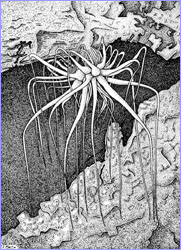 An undescribed vent anemone with three-foot-long
tentacles.
An undescribed vent anemone with three-foot-long
tentacles.
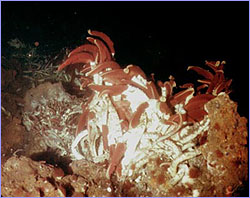 A bloom of tubeworms.
A bloom of tubeworms.
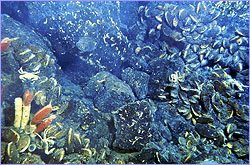 Mussels and tubeworms share a vent site.
Mussels and tubeworms share a vent site.
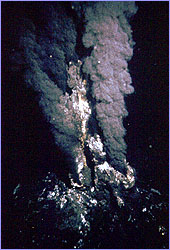 Venting black smoker chimney.
Venting black smoker chimney.
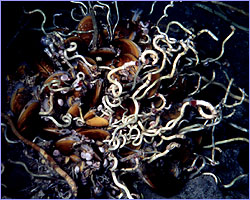 Swarming life at a cold seep on the Louisiana
Slope.
Swarming life at a cold seep on the Louisiana
Slope.
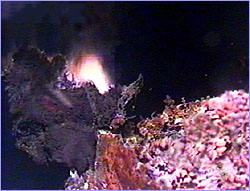 The hydrothermal vent known as 'Inferno.'
The hydrothermal vent known as 'Inferno.'
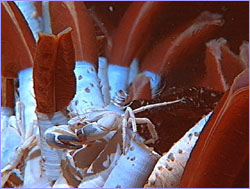 Crabs scavenge on giant tubeworms.
Crabs scavenge on giant tubeworms.